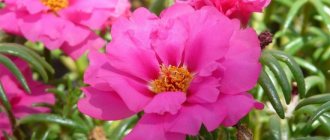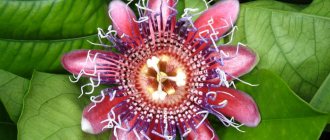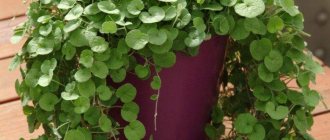Purslane, or dandur, is a plant that grows primarily in the tropics of the Northern and Eastern Hemispheres. The family has about two hundred species, which are located mainly near bodies of water. It was appreciated as a garden plant in the Middle Ages, when the English began to grow it near their homes.
In Russia, it can be seen in the wild in the Far East and the European part of the country. Domestic gardeners value it for its attractive appearance during the flowering period - the variety of flowers and shapes of stems, as well as the medicinal properties of purslane, make it a welcome guest in any garden or even on the windowsill in the house. In addition, the landscape design can be diluted with several varieties of dandur, which looks very presentable in parks or squares.
Annual and perennial purslane
There are both annual and hybrid species that can be grown for more than one year. At home, perennials rarely survive until next year. In the best case, it can be saved until the start of the new season by transplanting it into a pot during the cold weather.
However, some hybrids can do well both indoors and outdoors. In summer they grow outdoors, but in winter they can be safely moved indoors. This one lives for a long time, but it is unlikely to be able to please the eye with lush flowering - annuals are considered not so modest in terms of flowering.
If your goal is to get colorful, luxurious flowers, you should look towards annuals. Of course, it will have to be re-grown at the beginning of each season, but for the sake of appearance, many gardeners are ready to sacrifice their time.
By the way, there is a method that does not involve human intervention: you just need to plant it once and not dig up the soil near it, then the purslane will independently disperse the seeds from year to year. An important point is that this method is only relevant for warm climates, because the plant is considered heat-loving.
Types and varieties of purslane
Of the many species, only four are propagated by humans. They can often be seen in gardens or vegetable gardens.
The most common types:
| View | Description |
| Garden | An annual plant that in the wild can usually be seen along roads or in various ravines. Often compared to a weed due to its rate of reproduction. Famous for its medicinal properties. The optimal period for sowing is from May 20 to June 10. The leaves have a rather rough texture. |
| Ampelny | Hybrid obtained during selection. Grown in pots. Looks great on balconies. Flowers can be either double or simple. |
| Large-flowered | As a rule, it does not exceed 30 cm in height. It has lodging stems. Its leaves take the shape of a cylinder. The flowers reach a diameter of up to 7 cm and take the shape of a bowl. Thanks to selection, it was possible to develop not only a plant with red, but also white, and even cream. |
| Terry | Blooms all summer. Famous for its attractive petal shape. It closes the buds at night, and throughout the sunny day it beautifully decorates the garden. There are varieties that keep the buds open around the clock. |
Large-flowered purslane hybrids
Breeders have long begun work on developing varieties of this plant. Among the hybrids, the following stand out:
| Variety | Description |
| Double Mix | The buds with a complex structure can be of different shades; in fact, it is a mixture of several varieties of purslane. |
| Sanglo | Large buds that never close during flowering. |
| Air marshmallow | Relatively small variety. Inflorescences are white. They have a terry structure. |
| Cream | Various shades of beige during flowering period. |
| Splendence | The bright pink shade pleases the eyes. |
| Tequila White | A selectively bred hybrid. It is distinguished by flowers with a complex structure and a carpet of leaves that can reach up to 35 cm in diameter. It is not picky about moisture, so it can be watered infrequently. |
| Cherry | A relatively low plant with cherry-colored inflorescences. |
| Princely rug | A combination of white, red and bright orange colors. |
| Royal | During the flowering period, you can observe combinations of a wide variety of shades. |
| Sonya | Simple foliage harmonizes perfectly with luxurious blooms of different colors and medium-length stems. Suitable for growing in hot climates. |
| Pun | Multi-colored flowers of medium size. |
| Scheherazade | A large-flowered variety that shows itself in all its glory in July. The buds close at night and in cloudy weather. |
A little about the plant
The most common plant found in gardens is grandiflora purslane. It is this type that is the most decorative and boasts the brightest and largest buds. The plant is characterized by ground cover qualities: thanks to them, purslane forms a dense, picturesque carpet on the site.
Varieties
The gardener has the opportunity to choose purslane varieties based on the numerous assortment presented in specialized stores. You can purchase a variety with regular flowers or double flowers, in almost any shade and color. The following varieties are very popular:
- Pun - a mix of several multi-colored varieties;
- Red terry - purslane with bright, large buds;
- Pink double - a flower with lush heads of rich pink color;
- Sunny Country - purslane is a beautiful golden hue, its petals are double.
Propagation of purslane
You can grow a plant in the following ways:
- Seedling method. This option is considered the most effective. A suitable period for planting is the last days of February or the beginning of March, but it is also possible in April. To plant a house, you need to make sure that the soil is not too saturated with peat.
- Planting seeds in open ground. Seeds are planted in the ground in early summer. Recommended soil temperature is +20…+25 °C. At a lower temperature, the death of the sprouts is possible. The place chosen for planting should be well lit by the sun. The soil should be moistened, and after planting, cover them with polyethylene. When the first shoots appear, the film should be removed. The grown plant should be watered as the top layer dries.
- Wintering. Since climatic conditions in our country do not allow purslane to be grown in open ground, during the cold season the plant is grown indoors, where it is transferred for the winter. Dandur reproduces quite well on its own, so you don’t have to dig up the bed every year.
- Cuttings. Vegetative propagation is also possible. In the spring, you should cut the cuttings, remove excess foliage and put it all in water. When the roots form, you can start replanting them, after moistening the soil. The cuttings will do well where there is not sun all the time. A grown plant can be transplanted from partial shade to a permanent place of residence.
The choice of growing method should be based on preferences and the resources needed for proper growth.
Planting seedlings in open ground
Deadlines
Purslane seedlings are transplanted into open ground when the risk of return frosts has passed - May-early June.
This time differs in different regions due to climate:
- In the south of the country - in early May;
- In Siberia, the Urals, and the Leningrad region - early to mid-June;
- In the middle zone and Moscow region, in the Volga region - mid-May.
Important! If there is a chance that the air temperature will drop to 10 degrees or lower, it is better to postpone the transplant, otherwise the flowers will die.
Hardening
Hardening is carried out 2-3 weeks before planting in open ground. Then the seedlings will quickly adapt to new conditions and be more resistant to weather changes.
The seedlings are taken outside in warm weather - at least 15 degrees. For the first 2 days, open the window for several hours, then for 2 days, take the sprouts out onto the balcony or outside for 20 minutes, gradually increasing the time until the whole daylight hours.
Important! In the first days, the plants need to be shaded.
Selecting a location
Large-flowered or double purslane should be grown in an open and sunny area.
You should avoid waterlogged areas, lowlands where moisture accumulates, and places where groundwater is located close to the surface of the earth.
Important! It is better to plant purslane on hills with sandy or rocky soil.
In this case, it is better to choose poor soils, since on too fertile soils green mass will begin to develop, and flowering will not be lush.
Disembarkation scheme
Purslane seedlings are planted in open ground according to the following scheme:
- 2 hours before planting, seedlings are watered abundantly.
- Make holes in the area slightly larger than the size of the pot with seedlings, leaving 15-20 cm between them.
- The holes are watered with warm water.
- The seedlings, together with the earthen ball, are transferred into the holes.
- They deepen it to the same level at which it grew before.
- Carefully cover with soil and lightly compact.
- Plantings are watered with warm water.
Advice! The procedure is carried out in the morning or evening.
How to care for garden purslane
In order for the plant to grow for a long time and delight with beautiful flowers, you should consider the following recommendations for caring for it:
- Growth and flowering. To speed up growth, it is best to water dandur in hot weather. The water should not be at a very high temperature, and it should be poured strictly at the root. The procedure is performed approximately once a week. Ash can be used as fertilizer. To do this, it can be mixed with water, approximately 20 grams per liter of liquid. Usually does not require special fertilizers.
- How to collect and save seeds. Collecting seeds is also quite simple - you just need to promptly remove flowers that have faded. This is usually done in August and September.
However, you can completely refuse to collect seeds and give the plant the opportunity to propagate in its permanent place on its own, if the climate allows.
Outdoor care
Decorative purslane is easy to care for and drought-resistant. Even with a little care, the flower will bloom profusely and not get sick.
Watering
- During the first 7 days, the flowers are watered 2-3 times so that they take root faster.
- Water under the root with settled warm water.
- Watering should be moderate so as not to over-water the plants.
- In the future, when the purslane takes root, water it approximately once every 6 days.
- In hot weather and drought - a little more often.
Top dressing
There is no need to fertilize purslane, otherwise the leaves and stem will become thick and the flowers will become smaller.
Problems when growing purslane, diseases and pests
To be content with beautiful flowering, it is necessary to take into account a number of conditions necessary for purslane so that it can form healthy flowers. Most often the problem is the wrong choice of location or unsuitable soil. The plant does not bloom in the shade, and the soil should not be oversaturated.
There may be problems with growing from seeds in soil that was fertilized even a few months ago. Oily soil is a signal for growth, not reproduction. Adding sand or gravel solves the problem of dandur refusing to open buds.
Various parasites very rarely bother this plant. But if, nevertheless, aphids or thrips set their eyes on the sprouts, you can get rid of them with any insecticide. In fact, planting and caring for purslane should not be a problem for both experienced gardeners and novice hobbyists.
Growing purslane on a windowsill seasonally
Regardless of the variety, you should adhere to the following:
| Factor | Warm season (spring/summer) | Cold season (autumn/winter) |
| sunlight | Direct sunlight. | |
| Temperature | +20…+25 °C | With additional lighting +18…+25 °C |
| Ambient humidity level | No additional spraying is required. | |
| Watering frequency | Once every 5 days. | Once a week. |
Mr. Summer resident informs: purslane medicinal properties and medicinal uses
The medicinal properties of this plant have been known since ancient times. Previously, it was believed that dandur seeds were able to cleanse the human body of poisons and save them from death in case of any snake bite. There is also information that suggests that a mixture was prepared using the leaves to relieve swelling from the eyes.
Also, a number of historical sources report on the internal use of seed gruel, which was mixed with wine - this is how the Ancient Greeks relieved stomach pain and struggled with discomfort in the bladder area.
In Middle Eastern medicine, purslane was used as a remedy for warts or other skin diseases. Now the plants are recommended for those suffering from mild forms of diabetes.











